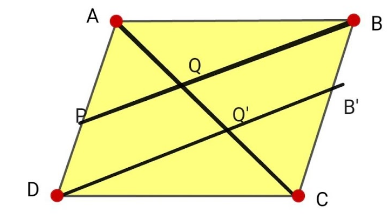
In a parallelogram ABCD, a point P is taken on AD such that AP : AD is 1:n. if BP intersects AC at Q, then AQ : AC is
A) 2/(n+1)
B) 1/(n-1)
C) 1/(n+1)
D) 2/(n-1)
Answer
577.2k+ views
Hint: We know that in a parallelogram opposite sides are parallel and equal in length. We will use this property of parallelogram and angle-side-angle congruent theorem of triangle to solve this problem.
Complete step-by-step answer:
Representing the data given in the above question into a diagram

Here ABCD is a parallelogram and AC is one of its diagonal.
P is a point on AD such that AP : AD is 1:n and BP intersects AC at Q
Let B’ be a point on BC and B’D intersects AC at Q’ and B’D is parallel to the BP
In the figure, \[PQ||Q'D\] and \[BP||B'D\]
So in ADQ’ triangle, $\dfrac{{AQ}}{{AQ'}} = \dfrac{1}{n}$ ………………(1)
Similarly in BCQ triangle, $\dfrac{{CQ'}}{{CQ}} = \dfrac{{CB'}}{{CB}}$
As ABCD and BPDB’ are parallelogram,
So, AD=BC
PD=BB’
And AP=CB’
As triangle APQ and triangle CB’Q’ are congruent as per angle-side-angle theorem,
Hence AQ=CQ’………….(2)
From equation (1) we have,
$\dfrac{{AQ}}{{AQ'}} = \dfrac{1}{n}$
By dividing one fraction by another we get,
$\dfrac{{AQ'}}{{AQ}} = n$
Adding 1 on both side of the above equation we get,
$\dfrac{{AQ'}}{{AQ}} + 1 = n + 1$
Simplifying the above equation we get,
$\dfrac{{AQ' + AQ}}{{AQ}} = n + 1$
Putting equation 2 in the above equation we get,
$\dfrac{{AQ' + CQ'}}{{AQ}} = n + 1$
As we know that, AQ’+CQ’ is AC, then substituting it in the above equation we get,
$\dfrac{{AC}}{{AQ}} = n + 1$
Flipping the terms of both of the side upside down,
$\dfrac{{AQ}}{{AC}} = \dfrac{1}{{n + 1}}$
Therefore AQ : AC is 1/(n+1)
Hence the option C is correct.
Note: In a parallelogram, opposite sides are parallel and equal with each other. Similarly opposite angles are also equal.
In the angle-side-angle congruent theorem of triangle, it is stated that if two angles and the included side of a triangle is equal with the same of another triangle, then the triangles are congruent.
You need to remember the theorem and properties of geometric shapes.
Complete step-by-step answer:
Representing the data given in the above question into a diagram

Here ABCD is a parallelogram and AC is one of its diagonal.
P is a point on AD such that AP : AD is 1:n and BP intersects AC at Q
Let B’ be a point on BC and B’D intersects AC at Q’ and B’D is parallel to the BP
In the figure, \[PQ||Q'D\] and \[BP||B'D\]
So in ADQ’ triangle, $\dfrac{{AQ}}{{AQ'}} = \dfrac{1}{n}$ ………………(1)
Similarly in BCQ triangle, $\dfrac{{CQ'}}{{CQ}} = \dfrac{{CB'}}{{CB}}$
As ABCD and BPDB’ are parallelogram,
So, AD=BC
PD=BB’
And AP=CB’
As triangle APQ and triangle CB’Q’ are congruent as per angle-side-angle theorem,
Hence AQ=CQ’………….(2)
From equation (1) we have,
$\dfrac{{AQ}}{{AQ'}} = \dfrac{1}{n}$
By dividing one fraction by another we get,
$\dfrac{{AQ'}}{{AQ}} = n$
Adding 1 on both side of the above equation we get,
$\dfrac{{AQ'}}{{AQ}} + 1 = n + 1$
Simplifying the above equation we get,
$\dfrac{{AQ' + AQ}}{{AQ}} = n + 1$
Putting equation 2 in the above equation we get,
$\dfrac{{AQ' + CQ'}}{{AQ}} = n + 1$
As we know that, AQ’+CQ’ is AC, then substituting it in the above equation we get,
$\dfrac{{AC}}{{AQ}} = n + 1$
Flipping the terms of both of the side upside down,
$\dfrac{{AQ}}{{AC}} = \dfrac{1}{{n + 1}}$
Therefore AQ : AC is 1/(n+1)
Hence the option C is correct.
Note: In a parallelogram, opposite sides are parallel and equal with each other. Similarly opposite angles are also equal.
In the angle-side-angle congruent theorem of triangle, it is stated that if two angles and the included side of a triangle is equal with the same of another triangle, then the triangles are congruent.
You need to remember the theorem and properties of geometric shapes.
Recently Updated Pages
Two men on either side of the cliff 90m height observe class 10 maths CBSE

What happens to glucose which enters nephron along class 10 biology CBSE

Cutting of the Chinese melon means A The business and class 10 social science CBSE

Write a dialogue with at least ten utterances between class 10 english CBSE

Show an aquatic food chain using the following organisms class 10 biology CBSE

A circle is inscribed in an equilateral triangle and class 10 maths CBSE

Trending doubts
Why is there a time difference of about 5 hours between class 10 social science CBSE

Write a letter to the principal requesting him to grant class 10 english CBSE

What is the median of the first 10 natural numbers class 10 maths CBSE

The Equation xxx + 2 is Satisfied when x is Equal to Class 10 Maths

Which of the following does not have a fundamental class 10 physics CBSE

State and prove converse of BPT Basic Proportionality class 10 maths CBSE




